
Irish Round Tower - $$3.00
Irish round towers are early medieval stone towers of a type found mainly in Ireland, with two in Scotland and one on the Isle of Man. Though there is no certain agreement as to their purpose, it is thought they were principally bell towers, places of refuge, or a combination of these. Generally found in the vicinity of a church or monastery, the door of the tower faces the west doorway of the church. In this way it has been possible to determine without excavation the approximate site of lost churches, where the tower still exists.
The Round Tower
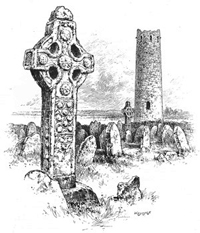 THE IRISH ROUND TOWER is a tall, cylindrical stone ancient structure found mostly in Ireland. Round towers were built near churches and monasteries between the 900's and 1200's. They were used as belfries for ringing handbells and as places of refuge during raids by Vikings. They vary in height from about 70 to 125 feet and in diameter from 13 to 18 feet. About 70 round towers still stand.
THE IRISH ROUND TOWER is a tall, cylindrical stone ancient structure found mostly in Ireland. Round towers were built near churches and monasteries between the 900's and 1200's. They were used as belfries for ringing handbells and as places of refuge during raids by Vikings. They vary in height from about 70 to 125 feet and in diameter from 13 to 18 feet. About 70 round towers still stand.
By the 1800's, people had forgotten the purpose of round towers. Some writers suggested that the towers had been built as Phoenician fire-temples, astronomical observatories, or tombs. Other even more outlandish explanations were offered. The true origin of the towers was rediscovered in 1833, when George Petrie, an Irish antiquarian, wrote a comprehensive essay on them.
Scattered with an apparent randomness across the rolling hills of Ireland are the remains of sixty-five round towers. Soaring as high as 34 meters above the ground, the towers are in remarkably fine condition considering the antiquity of their construction. When exactly the towers were constructed is unknown. Scholars have suggested however, that the most probable construction periods were between the 7th and 10th centuries AD (this hypothesis is based on the fact that nearly every tower is at the site of a known Celtic church dating from the fifth to twelfth centuries). Initially the towers were always free-standing structures but some have been surrounded by other buildings,
The purpose of the towers has been somewhat unclear until recent times. A popular theory in the past was that the towers were originally a redoubt against raiders such as Vikings. If a lookout posted in the tower spotted a Viking force, the local population (or at least the clerics) would enter, using a ladder which could be raised from within. The towers would be used to store religious relics and other plunderables.
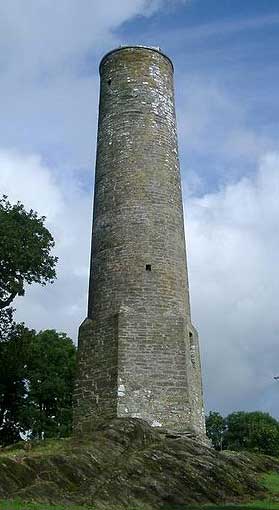 However, there are many problems with this theory. Many towers are built in positions which are not ideal to survey the surrounding countryside and would not work efficiently as watch towers for incoming attacks.
However, there are many problems with this theory. Many towers are built in positions which are not ideal to survey the surrounding countryside and would not work efficiently as watch towers for incoming attacks.
The doors to these towers would have been wooden and therefore easily burned down. Due to the almost chimney-like design of the towers, the smoke from the burning door would have been carried upwards inside the tower causing any occupants to suffocate. Indeed, the round towers at Dysert O'Dea and Aghagower show evidence of fire damage around the doorway. There are also records of people being burned to death in round towers.
The main reason for the entrance-way being built above ground level was to maintain the structural integrity of the building rather than for defence. The towers were generally built with very little foundation. The tower at Monasterboice has an underground foundation of only sixty centimetres. Building the door at ground level would weaken the tower. The buildings still stand today because their round shape is gale-resistant and the section of the tower underneath the entrance is packed with soil and stones.
The distance from the ground to the raised doorway is somewhat greater than that from the first floor to the second; thus large, rigid steps would be too large for the door. Excavations in the 1990s, revealing postholes, confirm that wooden steps were built. However, the use of ladders prior to the construction of such steps cannot be ruled out.
Therefore, the primary reason for the round tower was to act as a belfry imitating the continental European style of bell tower which was popular at the time. The Irish word for round towers, cloictheach, literally meaning bellhouse indicates this, as noted by George Petrie in 1845.
Thirteen towers retain a conical cap and it is assumed that all the other towers
once had similar caps that have fallen over the centuries. On
a small number of towers battlements have been built on to the top but it is known that these battlements were
added at a later date in the Middle Ages. The principles used in construction of the towers
is always the same:
Two walls of block and mortar construction are built a few feet
from one another and the space between is filled in with a core of rock rubble. This was
the standard method of wall construction utilized by the Romans and thus it has been
assumed that the building technology utilized in the Irish towers was brought to Ireland
by Christian missionaries who had learned the technique in England or continental Europe.
Writing of the dimensions of the towers in his book, Irish Round Towers, Lennox Barrow states: "It is remarkable how little the main dimensions vary. In the
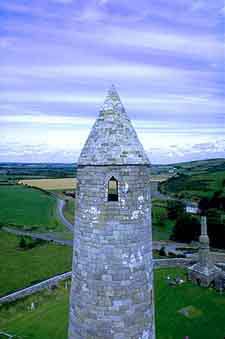 |
| Jutting high above the plain of Tipperary against the backdrop of the Galtee mountains is the 28 meter round tower of Cashel. While the tower dates from the 11th century, the rock outcrop upon which it stands has fortifications from the early 4th century when it was the stronghold and ceremonial center of a powerful clan. Patrick is said to have visited the site in 450 AD and hence one of its popular names, St. Patrick's Rock. |
great majority of towers the circumference at the base lies between 14 meters and 17 meters and the thickness of the wall at the lowest point at which it can be measured varies from 0.9 meters to 1.4 meters. Doorways, windows, storey heights and diameters also follow clearly defined patterns, and we may well conclude that most of the towers were the work of teams of builders who moved from one monastery to another using standard designs." Barrow goes on to say that: "Most doorways are raised 1.5 meters to 4.5 meters above the ground. This is usually explained as being for security, to enable the monks to take refuge inside the towers during times when Viking raiders or bandits were attacking the monasteries. There is probably some truth in this theory but it is possible that the stability of the tower had as much to do with the door heights. The higher you could build before making an opening in the wall the stronger the base would be. Very often the towers were filled in, even as high as the doorways."
Some interesting Far-Out thoeries...
This idea that the round towers were erected and used primarily as watch towers and places of protection is strongly debated by an American scientist, Philip Callahan.Writing in his book, Ancient Mysteries, Modern Visions, Callahan discusses research which indicates that the round towers may have been designed, constructed and utilized as huge resonant systems for collecting and storing meter-long wavelengths of magnetic and electromagnetic energy coming from the earth and skies. Based on fascinating studies of the forms of insect antenna and their capacity to resonate to micrometer-long electromagnetic waves, Professor Callahan suggests that the Irish round towers (and similarly shaped religious structures throughout the ancient world) were human-made antenna which collected subtle magnetic radiation from the sun and passed it on to monks meditating in the tower and plants growing around the tower's base.
The round towers were able to function in this way because
of their form and also because of their materials of construction. Of the sixty-five
towers, twenty-five were built of limestone, thirteen of iron-rich, red sandstone, and the rest
of basalt, clay slate or granite - all minerals which have paramagnetic properties and
can thus act as magnetic antenna and energy conductors. Callahan further states that the
mysterious fact of various towers being filled with rubble for portions of their
interiors was not random but rather may have been a method of "tuning" the tower
antenna so that it more precisely
resonated with various cosmic frequencies.
Equally intriguing, Callahan shows that the geographical arrangement of the round towers throughout the Irish countryside mirrors the positions of the stars in the northern sky during the time of winter solstice. Archaeological excavations at the bases of the towers have revealed that many towers were erected upon the tops of much older graves and it is known that many of the tower sites were considered sacred places long before the arrival of Christianity in Ireland. These facts compel us to wonder if the ancient Irish, like the Egyptians and the Mayans, understood there to be an energetic resonance between certain terrestrial locations and particular celestial bodies. This certainly seems to be the case. All across the Irish countryside certain locations were chosen, precisely designed structures were erected to gather and store various energies, and a tradition of humans' spiritual use of the sites arose over the millennia. While many of the round towers are now crumbling and therefore their antenna function may no longer be operative, a field of holiness still permeates the sites today.
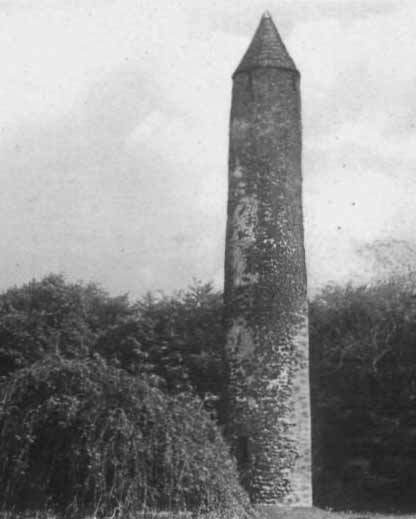 Antrim Round Tower |
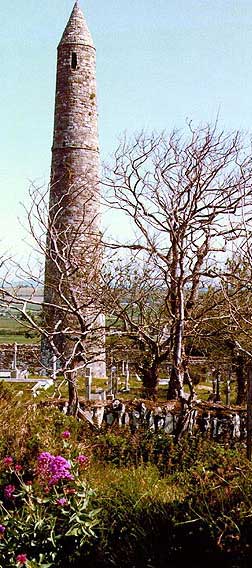 Ardmore Round Tower, Waterford |
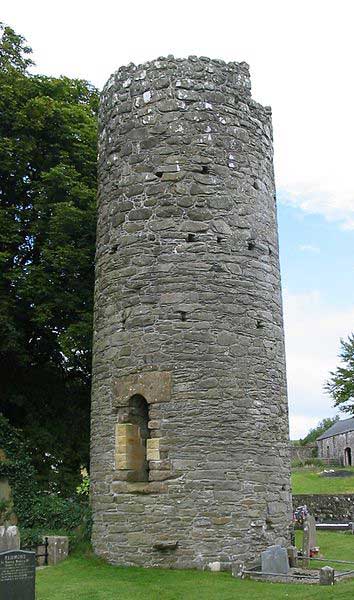 Armoy Round Tower in County Antrim |
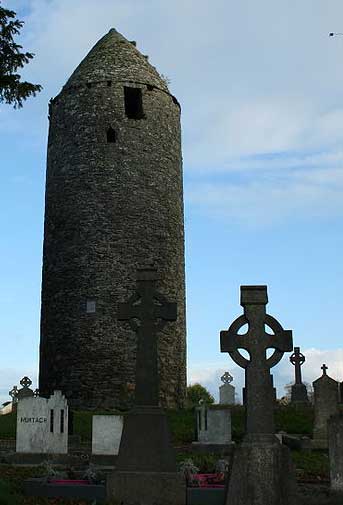 Dromiskan, Round Tower Ireland |
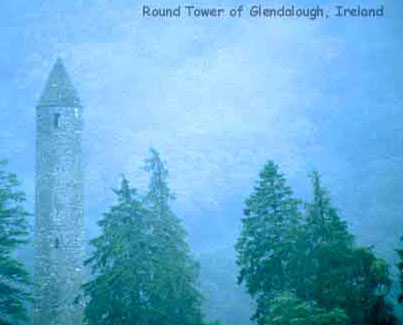 Round Tower of Glendalough, Ireland |
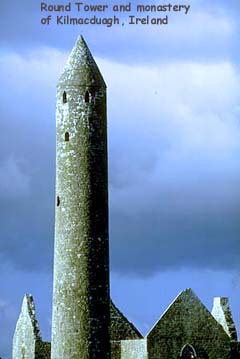 Closeup of Round Tower of Kilmacduagh, Ireland |
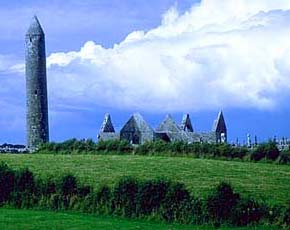 Round Tower and monastery of Kilmacduagh, Ireland |
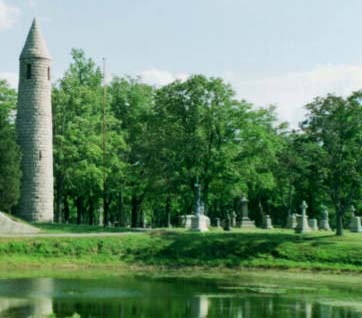 This Irish Round Tower actually lives in Milford Massachusetts |
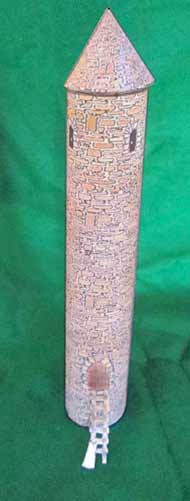 |
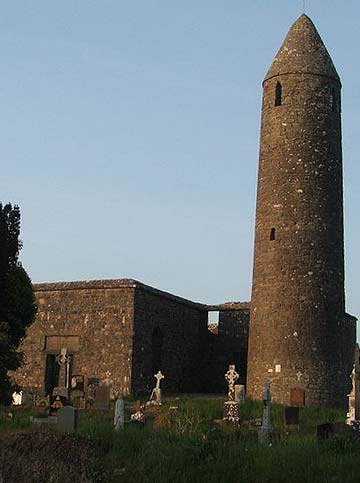 Turlough, Ireland, Round Tower |


